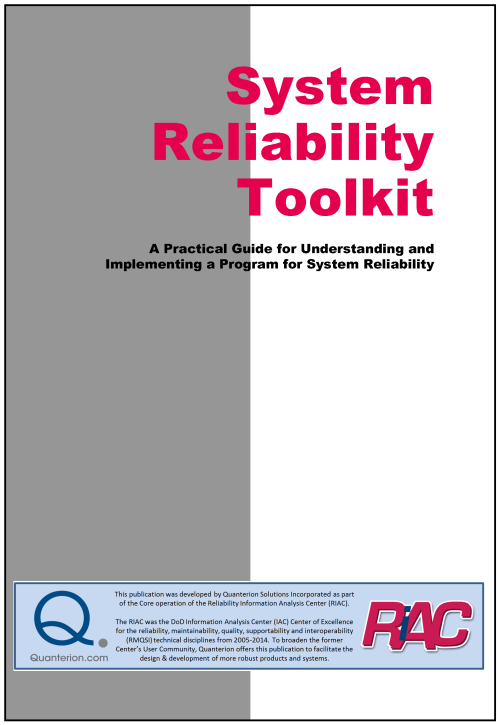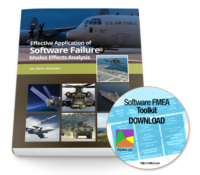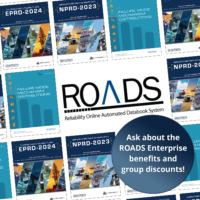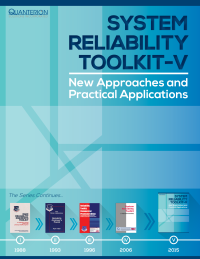The System Reliability Toolkit provides technical guidance in all aspects of system reliability, addressing both software reliability and human factors to better reflect the changing requirements of defense community.
System Reliability Toolkit
$40.00
Out of stock
Product Description
The RIAC, in a cooperative agreement with the DTIC IAC, the Data and Analysis Center for Software (DACS), has developed the next publication in the successful Reliability “Toolkit” series long-associated with the Reliability Analysis Center. Throughout the Reliability Toolkit series, the focus has been predominantly on hardware, with little attention given to software, and no attention given to human factors. DoD systems and commercial products, however, have become increasingly software-intensive, such that software has become virtually indistinguishable from hardware in addressing mission criticality and ensuring mission success. Additionally, interaction between humans and machines requires much more attention to gain a better understanding of the impact of human factors on overall system reliability. The System Reliability Toolkit provides technical guidance to the user in all aspects of system reliability. As a result, the user can better understand and implement those techniques necessary to ensure that system and product designs exhibit successful levels of hardware, software and human reliability, and that inherent risks associated with deficiencies in system reliability can be minimized.
Additional information
| ISBN: | 978-1-933904-01-6 |
|---|
Table of Contents
| Section 1.0 The Need for Reliability | 1 |
| 1.1 THE NEED FOR SYSTEM RELIABILITY | 3 |
| 1.2 CUSTOMER EXPECTATIONS | 5 |
| 1.3 MARKET COMPETITION | 8 |
| 1.4 AVAILABILITY AND OPERATIONAL READINESS | 13 |
| 1.5 LIFE CYCLE COSTS AND LCCA | 19 |
| 1.6 LIABILITY | 32 |
| 1.7 MILITARY NEEDS | 36 |
| 1.8 WARRANTIES | 42 |
| Section 2.0 Systems Engineering and Reliability | 53 |
| 2.1 THE SYSTEMS ENGINEERING PROCESS | 55 |
| 2.1.1 Identification of System Needs and Feasibility Analysis | 63 |
| 2.1.2 System Operational Requirements | 64 |
| 2.1.3 Functional Analysis and Allocation | 66 |
| 2.2 CONCEPTS RELATED TO SYSTEM R&M | 72 |
| 2.2.1 Logistics | 74 |
| 2.2.2 Supportability | 80 |
| 2.3 RELIABILITY OVER THE SYSTEM LIFE CYCLE | 81 |
| 2.4 OVERVIEW OF SOFTWARE RELIABILITY | 87 |
| 2.4.1 Software vs Hardware Reliability | 91 |
| 2.5 HUMAN ENGINEERING | 96 |
| 2.5.1 Elements of a Human Engineering Program | 99 |
| 2.5.2 Human Reliability Considerations for Systems | 102 |
| Section 3.0 Reliability and Maintainability Basics | 105 |
| 3.1 SYSTEM TECHNICAL PERFORMANCE MEASURES | 107 |
| 3.2 RELIABILITY AND MAINTAINABILITY DEFINITIONS | 111 |
| 3.3 THE BATHTUB CURVE | 113 |
| 3.4 RELIABILITY AND MAINTAINABILITY FIGURES-OF-MERIT | 114 |
| 3.4.1 Operational Parameter Translation | 121 |
| 3.5 SOFTWARE QUALITY METRICS | 124 |
| 3.6 HUMAN-MACHINE PERFORMANCE METRICS | 127 |
| 3.6.1 Human-Machine Reliability, Maintainability and Availability Metrics | 128 |
| 3.7 RELEVANT STATISTICAL CONCEPTS | 130 |
| 3.7.1 Probability Distributions | 134 |
| 3.7.1.1 Binomial Distribution | 139 |
| 3.7.1.2 Poisson Distribution | 141 |
| 3.7.1.3 Normal Distribution | 143 |
| 3.7.1.4 Exponential Distribution | 145 |
| 3.7.1.5 Gamma Distribution | 147 |
| 3.7.1.6 Weibull Distribution | 150 |
| 3.7.2 Statistical Hypothesis Testing | 154 |
| 3.7.2.1 Hypothesis Testing for Reliability Acceptance | 162 |
| 3.7.2.2 Hypothesis Testing for Reliability Growth | 165 |
| 3.7.2.3 Chi-Square Goodness-of-Fit Test | 167 |
| 3.7.2.4 Kolmogorov-Smirnov Goodness-of-Fit Test | 170 |
| 3.7.3 Parameter Estimation | 174 |
| 3.7.4 Confidence Bounds | 179 |
| Section 4.0 R&M Requirements and Programs | 185 |
| CUSTOMER REQUIREMENTS | |
| 4.1 PERFORMANCE-BASED REQUIREMENTS | 187 |
| 4.2 SPECIFICATION OF REQUIREMENTS FOR SYSTEM DESIGN | 191 |
| 4.2.1 Example R&M Requirements for a Supplier Specification or SOW | 193 |
| 4.3 QUANTITATIVE RELIABILITY REQUIREMENTS | 199 |
| 4.4 QUANTITATIVE MAINTAINABILITY REQUIREMENTS | 203 |
| 4.5 QUANTITATIVE TESTABILITY/DIAGNOSTIC REQUIREMENTS | 204 |
| 4.6 R&M INFORMATION FOR PROPOSALS | 207 |
| 4.6.1 Source Selection and R&M Evaluation Criteria | 208 |
| PROGRAM REQUIREMENTS | |
| 4.7 PROGRAM MANAGEMENT AND CONTROL | 212 |
| 4.8 PRODUCT DEVELOPMENT PHASE TERMINOLOGY | 214 |
| 4.9 RELIABILITY PROGRAM ELEMENTS | 215 |
| 4.10 R&M ACTIVITY PRIORITIES | 220 |
| 4.10.1 Human Engineering Relationship to Reliability | 221 |
| 4.11 NONDEVELOPMENTAL ITEM (NDI) CONSIDERATIONS | 223 |
| 4.11.1 Issues in COTS Hardware/Software Reliability | 227 |
| Section 5.0 Design | 233 |
| 5.1 PART RELIABILITY CONSIDERATIONS | |
| 5.1.1 Parts Selection, Application and Control | 235 |
| 5.1.1.1 Special Part Considerations | 242 |
| 5.1.2 Part Stress Derating | 248 |
| 5.1.3 Part Failure Modes/Mechanisms | 250 |
| 5.2 ASSEMBLY RELIABILITY CONSIDERATIONS | |
| 5.2.1 Thermal Management | 255 |
| 5.2.2 Interconnection Techniques | 257 |
| 5.2.3 Power Supply Design Checklist | 261 |
| 5.2.4 Testability Criteria (Assembly Level) | 263 |
| 5.3 SYSTEM/EQUIPMENT RELIABILITY CONSIDERATIONS | |
| 5.3.1 The System Design Process | 266 |
| 5.3.2 Benchmarking | 269 |
| 5.3.3 System/Equipment Reviews | 272 |
| 5.3.3.1 Human Engineering Design Reviews | 276 |
| 5.3.4 Design for Reliability | 278 |
| 5.3.5 System Fault Tolerance Techniques | 280 |
| 5.3.5.1 Software Fault Tolerance Techniques | 283 |
| 5.3.6 Environmental Characterization | 288 |
| 5.3.7 Critical Item Reliability | 292 |
| 5.3.8 Testability and Diagnostics | 293 |
| 5.3.8.1 Testability Criteria (System Level) | 297 |
| 5.3.9 System Electromagnetic Guidelines | 299 |
| 5.3.10 Unique Considerations for Dormancy | 301 |
| 5.3.11 Mechanical Systems | 304 |
| 5.3.12 Software Reliability Design & Development | 310 |
| 5.3.12.1 Waterfall Model | 317 |
| 5.3.12.2 Prototyping and Rapid Prototyping Models | 319 |
| 5.3.12.3 Spiral and WIN-WIN Models | 322 |
| 5.3.12.4 Software Reuse | 325 |
| 5.3.12.5 Software Inspection | 329 |
| 5.3.12.6 Concurrent Hardware/Software Development | 333 |
| 5.3.13 Design for Human Factors | 336 |
| 5.3.13.1 Anthropometric Factors | 338 |
| 5.3.13.2 Sensory Factors | 340 |
| 5.3.13.3 Strength and Endurance Factors | 342 |
| 5.3.13.4 Speed and Accuracy Factors | 344 |
| 5.3.13.5 Body Movement Factors | 345 |
| 5.3.13.6 Physiological Factors | 346 |
| 5.3.13.7 Human Engineering Design Tools & Methods | 353 |
| 5.3.13.8 Designing for Human Reliability | 356 |
| 5.3.13.9 Reliable Human Performance | 363 |
| 5.3.13.10 Factors Affecting Human Performance | 365 |
| 5.3.13.11 Time and Human Performance Factors | 368 |
| 5.3.14 Design for Maintainability | 372 |
| 5.3.14.1 System Maintainability Concepts | 374 |
| 5.3.14.2 System Maintainability Considerations | 376 |
| 5.3.14.3 System Interfaces and Connections | 382 |
| Section 6.0 Analysis | 385 |
| 6.1 TYPES OF RELIABILITY ANALYSES | 387 |
| 6.2 RELIABILITY MODELING | |
| 6.2.1 Hardware Reliability Modeling | 389 |
| 6.2.2 Software Reliability Modeling | 396 |
| 6.2.2.1 Time Domain Models | 400 |
| 6.2.2.2 Fault Seeding Model | 407 |
| 6.2.2.3 Input Domain Models | 409 |
| 6.2.3 Human Reliability Modeling | 411 |
| 6.3 ALLOCATION OF RELIABILITY REQUIREMENTS | 414 |
| 6.3.1 Allocation of Hardware Reliability Requirements | 415 |
| 6.3.2 Allocation of Software Reliability Requirements | 421 |
| 6.3.2.1 Allocation by Sequential Execution | 424 |
| 6.3.2.2 Allocation by Concurrent Execution | 425 |
| 6.3.2.3 Allocation by Operational Profile | 426 |
| 6.3.2.4 Allocation by Complexity Factors | 429 |
| 6.3.2.5 Allocation by Operational Criticality | 431 |
| 6.3.3 Allocation of Human Reliability Requirements | 433 |
| 6.4 RELIABILITY PREDICTION | |
| 6.4.1 Hardware Reliability Prediction | 437 |
| 6.4.1.1 Reliability Physics | 441 |
| 6.4.1.2 Reliability of Surface Mount Technology (SMT) | 444 |
| 6.4.1.3 Parts Count Reliability Prediction | 449 |
| 6.4.1.4 Reliability Adjustment Factors | 461 |
| 6.4.1.5 Reliability Prediction of Dormant Items | 463 |
| 6.4.1.6 Reliability Prediction of Mechanical Components | 464 |
| 6.4.1.7 Reliability Prediction Checklist | 473 |
| 6.4.2 Software Reliability Prediction/Estimation Overview | 474 |
| 6.4.2.1 Software Reliability Prediction | 480 |
| 6.4.2.2 Software Fault Estimation Using Tagging | 482 |
| 6.4.2.3 Prequential Likelihood Ratio | 484 |
| 6.4.2.4 Assessing Software Reliability Model Performance | 486 |
| 6.4.3 Predicting Human Reliability | 491 |
| 6.5 DATA COLLECTION AND ANALYSIS | |
| 6.5.1 Overview of Data Collection and Analysis | 498 |
| 6.5.2 Types and Sources of Data | 513 |
| 6.5.3 Use of Existing Reliability Data | 516 |
| 6.5.4 Human Reliability Data Sources | 517 |
| 6.5.5 Data Analysis Techniques | 520 |
| 6.5.5.1 Weibull Analysis | 525 |
| 6.5.5.2 Regression Analysis | 532 |
| 6.5.5.3 Analysis of Variance | 538 |
| 6.6 RELIABILITY ANALYSIS TECHNIQUES | 542 |
| 6.6.1 Failure Modes, Effects and Criticality Analysis (FMECA) | 543 |
| 6.6.2 Fault Tree Analysis (FTA) | 554 |
| 6.6.3 Worst Case Analysis | 567 |
| 6.6.4 Sneak Analysis | 573 |
| 6.6.4.1 Sneak Circuit Analysis | 577 |
| 6.6.4.2 Software Sneak Analysis | 579 |
| 6.6.5 Durability Analysis | 584 |
| 6.6.6 Finite Element Analysis | 588 |
| 6.6.7 Safety Analysis | |
| 6.6.7.1 Overview of Safety Analysis | 590 |
| 6.6.7.2 Software Safety Analysis | 594 |
| 6.6.8 Thermal Analysis | 601 |
| 6.6.9 Electromagnetic Analysis | 605 |
| 6.6.10 Human Factors Analysis | 608 |
| 6.6.11 Maintainability/Testability Analysis | |
| 6.6.11.1 Maintainability Analysis | 609 |
| 6.6.11.2 Testability Analysis | 610 |
| 6.6.11.3 Maintainability/Testability Analysis Checklist | 611 |
| 6.6.12 Reliability-Centered Maintenance | 612 |
| Section 7.0 Testing | 621 |
| 7.1 SYSTEM TEST REQUIREMENTS | 623 |
| 7.2 RELIABILITY TESTING | 627 |
| 7.2.1 Reliability Test Strategies | 628 |
| 7.2.2 Software Reliability Test Strategies | 632 |
| 7.3 DESIGN OF EXPERIMENTS (DOE) | 636 |
| 7.4 ACCELERATED AND HIGHLY ACCELERATED TESTING | 646 |
| 7.4.1 Acceleration Factors Used in Life Models | 649 |
| 7.4.2 Accelerated Life Testing | 656 |
| 7.4.3 Highly Accelerated Testing | 665 |
| 7.4.3.1 Step-Stress Testing | 669 |
| 7.4.3.2 Highly Accelerated Life Test (HALT) | 671 |
| 7.5 RELIABILITY GROWTH AND RELIABILITY DEMO/QUAL TESTING | 673 |
| 7.5.1 Reliability Growth Testing | 675 |
| 7.5.1.1 Software Reliability Growth Testing | 680 |
| 7.5.2 Reliability Demonstration/Qualification Testing | 684 |
| 7.6 RELIABILITY SCREENING | 699 |
| 7.6.1 Environmental Stress Screening (ESS) | 704 |
| 7.7 ELECTROMAGNETIC TESTING | 708 |
| 7.8 SOFTWARE RELIABILITY TESTING | 710 |
| 7.8.1 Software Test Coverage Metrics | 713 |
| 7.8.2 Software Statistical Usage Testing | 717 |
| 7.8.3 Operational Profile Testing | 725 |
| 7.8.4 Markov Testing | 731 |
| 7.9 HUMAN FACTORS TEST AND EVALUATION | 736 |
| 7.9.1 Human Engineering Test and Evaluation Activities | 738 |
| 7.9.2 Testing for Human Reliability | 740 |
| 7.10 MAINTAINABILITY/TESTABILITY TEST STRATEGIES | 744 |
| 7.10.1 Maintainability/Testability Demonstration Testing | 752 |
| 7.11 FAILURE REPORTING, ANALYSIS AND CORRECTIVE ACTION SYSTEM | 756 |
| 7.11.1 Root Cause Failure Analysis | 766 |
| Section 8.0 Production and Beyond | 773 |
| 8.1 STATISTICAL PROCESS CONTROL AND SIX-SIGMA | 775 |
| 8.2 CONTINUOUS IMPROVEMENT | 788 |
| 8.3 LIFETIME EXTENSION ASSESSMENT | 797 |
| APPENDIX A Example Hardware Reliability Design Guidelines | 804 |
| APPENDIX B R&M Standardization Documents | 814 |
| APPENDIX C Reliability and Maintainability Education Sources | 830 |
| APPENDIX D Acronyms | 834 |
You may also be interested in…
-
Electronic Derating for Optimum Component Reliability: Special Bundle Edition
Starting at: $350.00 -
Sale!
Get Three Reliability Publications for 15% Off!
$280.00$238.00 -
System Reliability Toolkit-V
Starting at: $90.00








